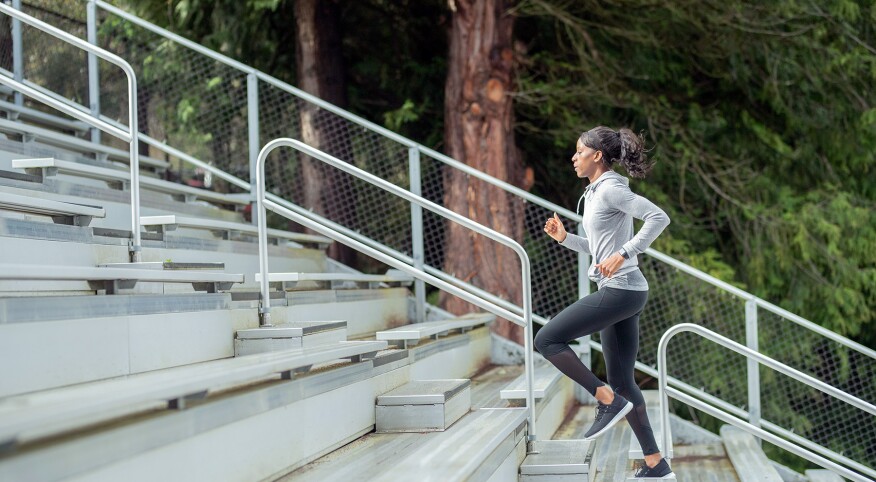When was the last time you walked up a couple of flights of stairs just for the heck of it? If you’re like many of us, you probably take the stairs only when it’s absolutely necessary. After all, that climb up is hard. We hear you. But the temporary discomfort is well worth the many benefits. Here’s why you should add stair-climbing — whether at home, at work, at a stadium or at the gym using a machine — to your daily routine.
It sculpts your bottom half. Climbing stairs targets all the major muscles in your legs, including your hamstrings, quadriceps and calves. And we can’t forget the glutes. By building muscle in the hamstrings, the quads and the calves, stair-climbing activates the butt, which causes it to have better shape and definition, says Beverly K. Johnson, owner of Genesys Fitness (GenFit) in Huntsville, Alabama.
Your core will get a good workout. “There’s a myth that the only way to tone up your abs is by doing a bunch of sit-ups or other ab work,” says Johnson. However, when you climb stairs, “it engages your core because it requires you to keep your balance the whole time,” she explains. That core activation can strengthen and tone your abdominal muscles (though it will take a combination of exercise and a healthy diet to melt away any belly fat before you see the coveted six-pack). A strong core helps improve your posture, prevent lower-back pain and reduce your risk of injury, says Johnson.
It will make your heart happy. Aerobic exercise like stair-climbing helps strengthen your heart and reduces your risk of heart disease, stroke, heart attacks and high blood pressure. It also increases your HDL (“good”) cholesterol and lowers your LDL (“bad”) cholesterol.
Climbing stairs aids with weight loss and maintenance. Like other aerobic activities, if combined with a healthy diet, stair-climbing can assist you in dropping unwanted pounds and keeping them off. In fact, using the stairs burns serious calories. For example, according to Harvard Medical School, during a 30-minute stair-climbing workout, a 155-pound person can burn around 215 calories. Someone who’s 185 pounds can burn about 250 calories. In comparison, walking for 30 minutes at a 4-mph pace burns about 175 calories for someone who’s 155 pounds and 190 calories for a 185-pound person.
It preserves your bone mass. Bone density decreases as we get older, especially after menopause. That can lead to osteoporosis. Stair-climbing is a weight-bearing exercise, meaning it works your bones and muscles against gravity. That extra load on the bones causes them to become stronger and helps prevent further bone loss.
Stair-climbing is low impact. Not interested in doing high-impact activities like running or jumping? As long as you maintain good posture, climbing stairs is a low-impact activity that allows you to still get a good workout without hurting yourself, Johnson says. That’s perfect if you’ve got cranky knees or a bad back, or if you’re packing a few extra pounds.
Tips for stair-climbing:
- Practice good form. Place your entire foot on the step (no climbing using your toes while your heels hang off the edge). Hold on to the rails for balance, if necessary, but don’t lean over. Leaning over encourages poor posture and can lower the effectiveness of the workout, Johnson says. Standing up straight, she adds, will better engage the core and activate the lower body.
- Start slow. If you’re new to this or haven’t worked out regularly, start with five or 10 minutes. Then slowly increase your time or climb more flights of stairs.
- Break it up. It’s OK to do small chunks of exercise. The goal is to get moving, so if you have to break it into three 10-minute sessions throughout the day or 15 minutes in the morning and 15 minutes in the evening, it still adds up, Johnson says.
- Check your shoes. Make sure your shoes fit properly, provide proper support, have nonskid soles and aren’t worn out. Not having good footwear can cause back pain or knee pain, Johnson says.
- Step it up. Once you’ve been doing stairs for a while, Johnson recommends adding variety to your workout. Increase your speed (or resistance if using a stair-climber). Take two steps at a time. Do intervals by speeding up for a short amount of time and then slowing down for a bit to recover. Those things will boost your calorie burn and keep your workouts interesting. Now, get to stepping!











